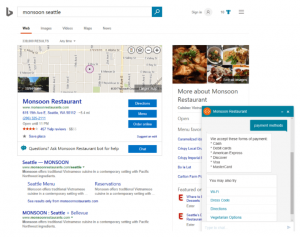
Are we still talking about data?
In this day and age do we really need to tout the necessity of good data? You bet! Although, you wouldn’t think so from the way you hear people talking about it. Data is last year’s topic and practically everybody under the sun is tired of it except for the fact that with the rise of Account Based Marketing (ABM), the data chimera is back and it needs to be conquered once more.
The switch from inbound marketing to ABM is one from lists to accounts. That’s the same shift in complexity as a bunch of astrophysicists going from launching bottle rockets to putting a man on the moon.
That is to say, it requires much more and much better data. It’s thus critical to make sure that you refresh on good data to be successful in ABM. After all, it’s only through building a good foundation that you’ll see the types of ROI that everybody else is talking about.
Here are the 3 ways good data supercharges your ABM launch:
1) Improves account selection, boosting average contract value (ACV) by 35-40%
Better data leads to better accounts. Account selection, after all, is where the proverbial ABM opportunity rockets are launched and if they’re not chosen carefully, your challenger sale may turn into a challenger shuttle. As Sam Laber, Director of Marketing at Datanyze puts it:
“You’re only going to have the bandwidth to effectively work a certain number of accounts. And if you pick the wrong ones, you’re going to be wasting your team’s time on leads that won’t amount to anything.”
Good data allows you to pick out only the accounts with the most receptive executive teams and the biggest land-and-expand opportunities.
To improve your selection process, your team will need more of these 4 data points to consider:
- Firmographics: You can never be too up-to-date on the basics like employee count, location, market cap, and growth. If you’re light on these or know that they’ve been ravaged by time, head back to your prospects’ annual reports, have SDRs scrub data from LinkedIn, or use third party data sources such as Dun & Bradstreet and Reachforce.
- Technographics: Knowing what technologies your target company uses such as CRMs or ERPs can give you a sense of whether an investment in your technology is more or less likely. This data can be gathered through a combination of competitive intelligence firms like HG Data, web-scraping firms like BuiltWith or Datanyze, and old-fashioned desk-work looking through job boards and social media.
- Intent Data: This is data on revealed buying behaviors not just from individual prospects, but the entire account – things like them posting multiple articles about your category, mentioning your industry in a keynote, or putting up multiple job requisitions with skillsets related to your solution. To gather it all, look to forums, job boards, and intent data vendors like Bombora, MRP, and The Big Willow.
- Engagement Data: This is the record of all engagements with your company past and present, such as historical deals, connections, web analytics, and scoring. Together, these tell you how hot the account is. To collect it, ensure that your marketing automation and ABM systems are properly integrated into your CRM, and that sales activities are actually being logged.
You can then use this data in your account scoring system, like so:

Accurately seeing that companies have the right techno/firmographics and knowing the depth of their intent and engagement allows your team to choose far better rockets to launch. So much so that studies show that better data which leads to better account selection can result in a 35-40% higher average contract value (ACV) for each account that’s landed.
2) Enhances contact selection, leading to 50% shorter sales cycles
Good data doesn’t stop with the account selection. To properly target your ABM efforts, you need to understand the people that the account is made up of, including their place on the organizational chart, personal goals, and relative decision-making authority. Together, this data allows you to much better maneuver within the account.
Specifically, you’ll need this data on each individual:
- Account affiliation
- Title
- Tenure
- Decision-making hierarchy
- Activity/engagement history
- Experience with your category
With this data in hand, you can build a metric for “influence” into your buyer personas. This helps you understand how deals will actually get done, as opposed to what you might expect from their organizational chart.
As the Harvard Business Review puts it, “much of the real work of companies happens despite the formal organization.” Action groups, eager junior managers, and outspoken subject matter experts are often the real power behind the throne.
Knowing that someone is a former user and highly engaged despite a lower-level title will allow your team to focus their efforts on the most avid and capable internal champions.
If you’re leveraging ABM software (like Engagio), the system goes even further and can automatically track and identify them for you, turning the entire decision-making team into an open book.
Would you like to take a guess at how many people that buying team usually ends up being? It’s 17. If that number seems surprisingly high, it will surprise your sales team as well, who typically only engage 4-5 of them. With ABM, you can ensure that they all get personalized outreach.
Building out this data set in ABM is, of course, one of the most time-consuming activities of the bunch. You first have to standardize your data fields across your organization (a challenge unto itself), ensure proper sales logging, import or append contact data using providers such as Dun & Bradstreet and Leadspace, and then set systems in place to maintain that quality over time.
The result of getting this contact data piece right is that it streamlines ABM deals and sends them flying through the funnel-like missiles, decreasing sales cycles by as much as 50%.
3) Refined playmaking, resulting in a 285% increase in close ratios
ABM ensures that deals are won because takes the 1:1 personalization that marketers have achieved with leads using marketing automation and applies it to the account as a whole. It recognizes the behaviors, wants, and needs of all actors, both internal and external, and organizes your team’s efforts toward them into plays.
To organize those plays effectively, your system needs to know everything that’s going outside of the traditional firmographics and contact data. You’ll need data on:
- The target’s market
- SWOT of the target company
- The relationships inside the account
- Your connections to the account
This data can inform your ABM program which pieces are most relevant to each particular account and to whom the most personalized outreach should be tailored to.
Data-powered plays spell the end to overlapping SDR outreach, to early-stage marketing emails landing in a late stage deal, and to eleventh-hour roadblocks from previously uninvolved decision makers. It focuses your entire organization in on the right people at the right time to get the deal done.
Data on the target’s market, SWOT, and outlook can be drawn from annual reports and providers like Dun & Bradstreet whereas relationships and connections can be seen through sales teams, sales tools, and ABM software.
This result of a marketing and sales cycle coordinated by accurate and effective plays is a 285% increase in close ratios for large enterprise accounts and a 166% increase in close ratios for mid-market accounts.
Not bad for a little cooperation, huh?
Putting it all together
Is the need for good data plenty clear? We hope so. We’re all in this journey together, ourselves included, and want to help you slay the bad data chimera and empower your organization to sell effectively. After all, ABM isn’t just a marketing campaign, it’s a business process that can help you achieve much higher returns than classic inbound marketing can alone.
Good data arms your team of rocket scientists with everything that they need to coordinate an ultra-complicated shuttle launch so that you can explore the universe of revenue success that’s out there!
Want to improve your data? Use the Account Based Everything Market Map to see what pieces are missing in your own rocket-launch program.
Business & Finance Articles on Business 2 Community(46)







